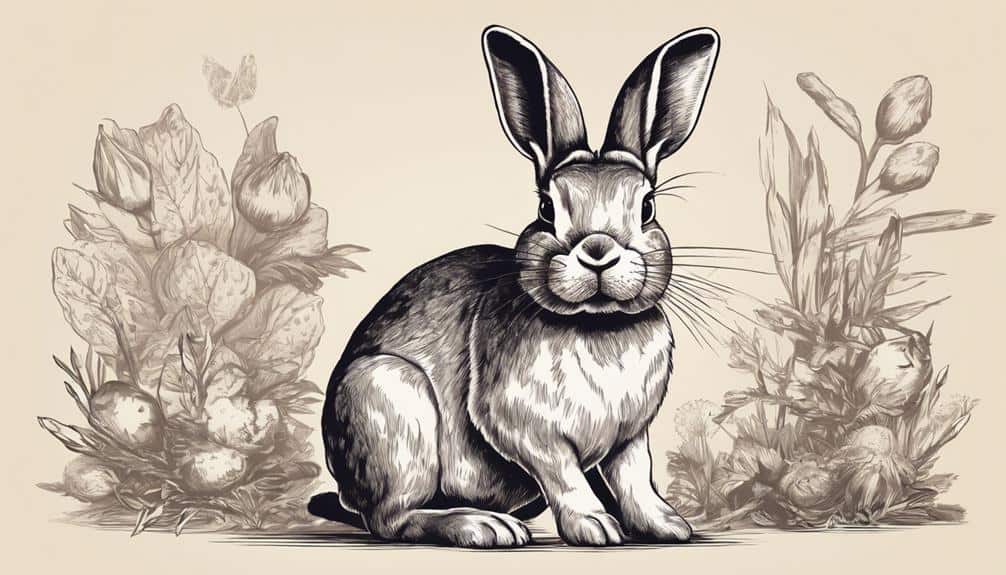Have you ever wondered why rabbits use thumping as a form of communication?
While some suggest it's solely a warning signal, there's more to this behavior than meets the eye.
Understanding the intricate reasons behind a rabbit's thumping can shed light on their emotional state and needs, ultimately leading to a deeper connection between you and your furry companion.
Stay tuned to uncover the fascinating world of rabbit communication through thumping and unravel the mystery behind this intriguing behavior.
Contents
- 1 Key Takeaways
- 2 Reasons for Rabbit Thumping Behavior
- 3 Communication Signals Through Thumping
- 4 Interpretation of Rabbit Thumps
- 5 Thumping as a Warning Mechanism
- 6 Emotional Triggers for Rabbit Thumping
- 7 Responding to Rabbit Thumping
- 8 Understanding Your Rabbit's Thumping Patterns
- 9 Frequently Asked Questions
- 10 Is Thumping the Only Way Rabbits Communicate, or Do They Have Other Methods as Well?
- 11 Conclusion
Key Takeaways
- Rabbit thumping serves as a crucial communication tool for signaling danger and expressing emotions.
- Thumping conveys various messages, indicating emotional states and seeking attention effectively.
- Understanding the types and impact of rabbit thumps is essential for interpreting communication accurately.
- Building a trusting bond with rabbits involves responding calmly to thumping, observing triggers, and creating a safe space.
Reasons for Rabbit Thumping Behavior

Rabbits thump for various reasons, including signaling danger, expressing emotions, and drawing attention to specific stimuli in their environment. This behavior is deeply ingrained in a rabbit's instincts as a prey species. When a rabbit perceives a potential threat nearby, they'll thump to alert other rabbits in the vicinity, communicating a sense of danger.
Apart from signaling risks, thumping can also convey a range of emotions such as playfulness or agitation. The intensity and frequency of thumping can vary based on the individual rabbit's personality and the specific triggers present in their surroundings. Understanding why a rabbit is thumping is important for interpreting their emotional state accurately.
Communication Signals Through Thumping
Signaling through thumping, rabbits convey a range of messages to communicate potential threats, discomfort, or a need for attention in their environment. When observing a rabbit thump, consider the following:
- Threat Detection: Rabbits use thumping as a way to alert others about potential dangers in their surroundings. The rhythmic sound of their hind feet hitting the ground serves as a warning signal for predators or other perceived threats.
- Emotional State: The frequency and intensity of thumping can indicate the level of annoyance or discomfort the rabbit is experiencing. It's essential to pay attention to these cues to understand their emotional well-being.
- Seeking Attention: In some cases, rabbits may thump to seek attention from their companions or caretakers. This behavior can signify a need for interaction, food, or a desire for companionship.
Interpretation of Rabbit Thumps

When observing rabbit thumps, it's important to note the subtle differences in their meaning, types, and impact.
Different types of thumps can convey various messages, indicating fear, stress, attention-seeking, or specific needs.
Understanding these distinctions will help you interpret your rabbit's communication accurately.
Rabbit Thumps Meaning
Thumping behavior in rabbits serves as a multi-faceted form of communication, conveying various messages related to their well-being and interactions within their environment. When interpreting rabbit thumps, consider the following:
- Warning Signals: Rabbit thumps often indicate danger, stress, or discomfort, alerting others to potential threats in the surroundings.
- Emotional Expression: The frequency and intensity of thumps can reflect the rabbit's emotional state, signaling annoyance, the desire for attention, or a need for food or interaction.
- Social Communication: Rabbits use thumping as a way to communicate with their warren members, establishing a form of non-verbal interaction that's important for their communal living arrangement. Understanding the context and accompanying body language is key to deciphering the true meaning behind these thumps.
Types of Rabbit Thumps
In understanding rabbit communication through thumping, recognizing the distinct types of thumps plays a vital role in deciphering their messages and emotional cues. Rabbit thumping serves as a form of communication for these prey animals, with different thump patterns indicating various meanings.
For instance, thumping at night may signal danger alerts or territorial warnings. Annoyance or distress can be conveyed through repetitive and intense thumps, often accompanied by negative body language. On the other hand, playful thumps are characterized by more energetic movements and positive body language, reflecting a lighter mood.
Understanding these different types of thumps and their contexts is essential for interpreting a rabbit's emotional state accurately and responding appropriately to their needs.
Impact of Rabbit Thumps
Indicative of various emotional states and needs, rabbit thumping serves as a nuanced form of communication among these sensitive creatures. When interpreting rabbit thumps, consider the following:
- Signaling Fear and Stress: Rabbit thumping can be a sign of fear or stress, alerting others to potential dangers in the environment.
- Seeking Attention: Thumping may also indicate a rabbit's desire for attention, signaling a need for interaction or care.
- Expressing Needs: Understanding the context and accompanying body language is essential for interpreting thumps that signify requests for food, playtime, or social engagement.
Thumping as a Warning Mechanism

When rabbits thump, they're effectively alerting their fellow rabbits of potential threats both above and below ground through the vibrations they create. This warning mechanism is important for rabbit communication, as it allows them to signal danger to their group.
Thumping isn't just about making noise; it's accompanied by alert body language, with ears forward to signal nearby danger. This behavior helps rabbits remain vigilant and ready to respond to any potential threats that may arise.
By using thumping as a defense mechanism against predators, rabbits deter them by signaling their readiness to defend themselves. This constant vigilance and quick communication through thumping guarantee that rabbits can stay safe in the face of various dangers in their environment.
Emotional Triggers for Rabbit Thumping
Identifying emotional triggers for rabbit thumping provides valuable insights into their communication patterns and behavioral responses. When observing your rabbit's behavior, consider the following emotional triggers for thumping:
- Fear: Rabbits may thump when they feel scared or threatened by something in their environment. It could be a sudden loud noise, a new object, or a predator's scent nearby.
- Stress: High levels of stress can lead to rabbit thumping as a way to release tension or communicate their discomfort. Changes in routine, overcrowded living spaces, or aggressive behavior from other pets can all contribute to stress-induced thumping.
- Danger: Rabbits have a keen sense of danger, and they may use thumping as a warning signal to other rabbits or their human companions. If your rabbit senses an imminent threat, such as a potential predator or unsafe situation, they may start thumping to alert others and express their concern.
Understanding these emotional triggers can help you create a safe and comfortable environment for your rabbit, ensuring they feel secure and content in their surroundings.
Responding to Rabbit Thumping

To address rabbit thumping effectively, consider responding calmly to their signals to alleviate stress and fear. When your rabbit starts thumping, pay close attention to the context and potential triggers. By observing these cues, you can gain valuable insights into your rabbit's emotional state.
Creating a safe environment is important in reducing the frequency of thumping behavior. Make sure that your rabbit feels secure and comfortable in their surroundings. If thumping persists despite your efforts, seeking professional guidance may be necessary to address any underlying issues.
Building a trusting bond with your rabbit through positive interactions can also help in managing and understanding their thumping communication. Remember, responding with patience and attentiveness can go a long way in reassuring your rabbit and fostering a harmonious relationship.
Understanding Your Rabbit's Thumping Patterns
Understanding your rabbit's thumping patterns reveals valuable insights into their communication methods and emotional well-being. By observing your rabbit's thumping behavior, you can gain a better understanding of what they might be trying to convey. Here are three key points to contemplate when deciphering your rabbit's thumping patterns:
- Rabbit Body Language: Pay attention to your rabbit's overall body language when they're thumping. Are their ears perked up or flattened? Is their body tense or relaxed? These cues can provide clues about the underlying emotions driving the thumping behavior.
- Environmental Influences: Think about the environment in which your rabbit is thumping. Are there loud noises, unfamiliar scents, or other pets around? Rabbits may thump more frequently or intensely in response to perceived threats in their surroundings.
- Instinctual Responses: Remember that thumping is a natural behavior rooted in a rabbit's instincts as a prey species. Understanding this innate response can help you interpret your rabbit's communication more effectively and respond appropriately to their needs. By observing their thumping patterns in different contexts, you can build a stronger bond with your rabbit and guarantee their well-being.
Frequently Asked Questions
What Does It Mean When a Rabbit Thumps?
When a rabbit thumps, it's a important rabbit behavior that conveys stress signals through a communication method rooted in body language. Pay attention to these behavioral cues as they reveal the rabbit's emotions and the specific thumping meaning.
Are Rabbits Happy When They Thump?
When rabbits thump, they might not be happy. Thumping is a way for them to communicate distress or alert others. Understand their body language and emotions to differentiate between happy and stressed behavior.
Why Does My Rabbit Thump in the Middle of the Night?
When your rabbit thumps in the middle of the night, it could be related to their nighttime behavior, instincts, sleep disturbances, emotions, nocturnal habits, seeking attention, and using thumping as a communication method. Check for any potential issues.
How Do Rabbits Communicate?
Rabbits communicate through a variety of methods. They use visual cues, scent marking, vocalizations, social grooming, body language, and territory marking. Aggressive behavior is also a form of communication for rabbits to express themselves effectively.
Is Thumping the Only Way Rabbits Communicate, or Do They Have Other Methods as Well?
Rabbits indeed use more than just thumping to communicate. Along with insights into rabbit thumping, they also use body language, vocalizations, and scent marking. By combining these methods, rabbits can convey a wide range of emotions and intentions to other rabbits and their human companions.
Conclusion
To sum up, understanding why rabbits use thumping to communicate is vital for their well-being.
By paying attention to their thumping patterns and body language, you can decipher their emotions and needs more effectively.
While some may dismiss rabbit thumping as simply noise, recognizing its significance can strengthen the bond between you and your furry friend.
Remember, listening to your rabbit's communication cues is essential in providing them with the care and attention they deserve.






